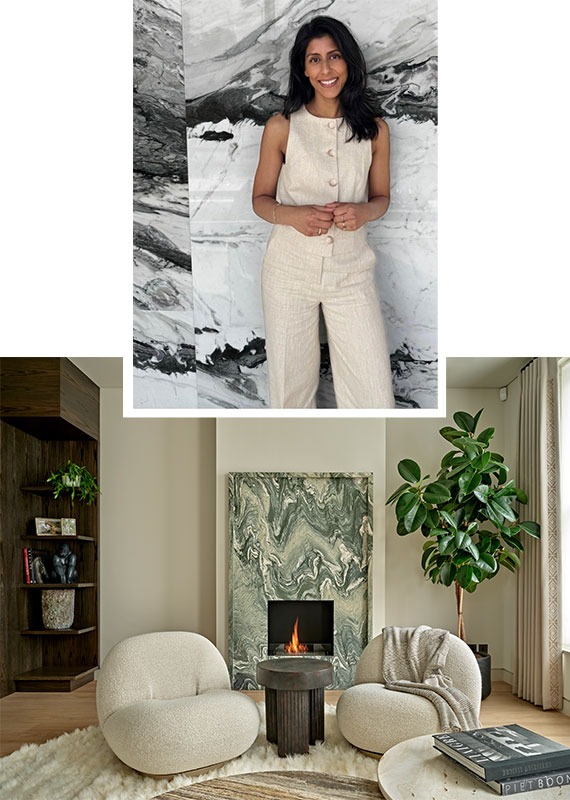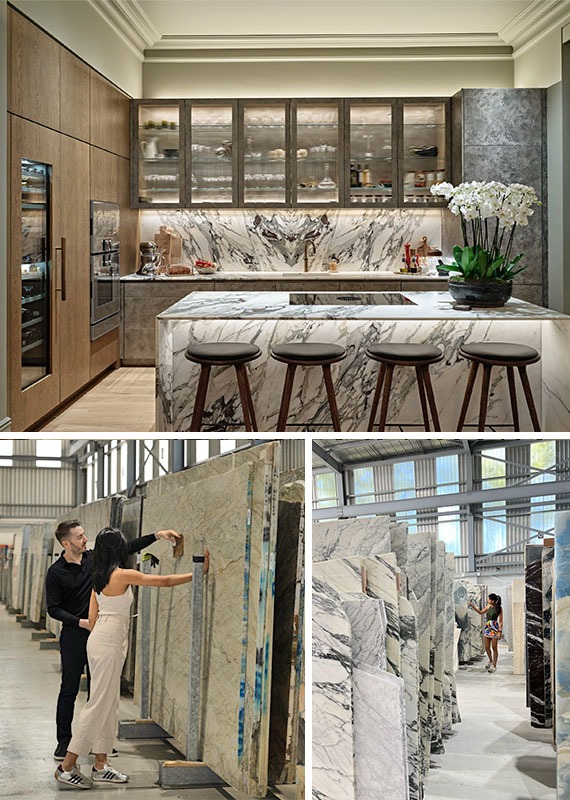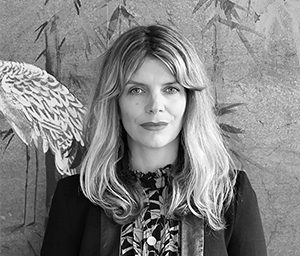You trained as an engineer – how does that shape your creative process today?
I’m inherently creative, which is why pursuing an engineering degree seemed an odd choice for me. But the part I’ve always found most fascinating is exploring where design meets purpose. Simple training like doing drawings in AutoCAD, seeing exploded views of objects, and disassembling a mechanical product and being able to piece it back together, all provided an extra dimension of ‘sight’ for me creatively.

I find that when I see a particular stone, I can imagine the cuts in places and how it would look installed in a space. It’s especially useful when curating stone for our warehouse, Stone Atelier, with my dad, but also allows me to give clients more in-depth assistance with their stone choices. I can look at design schemes and suggest stone choices that would fi t together well or help clients understand how a slab can translate and transform a space.
How are designers and clients using stone right now?
Marble has always been perceived as an aspirational material in design, and remains so today. The shift we’ve noticed is the extent to which natural stone is now used. If a client has a limited budget, they may opt for stone accents in the form of a door frame, fireplace surround or even a small coffee table. Clients who want their space to exude luxury are choosing stone in multiple rooms and in abundance. The concept of a natural stone feature wall, or drenching an entire bathroom in the same stone type has become more common. Tastes have also changed. There’s been a big shift from the more classically neutral Carrara type marble to the more dramatic; the statement makers. Bold veining aside, there’s been a shift from cooler blue-grey tones to warmer beige, yellow, pink, red and greens.
How do you balance curating timeless pieces with tapping into what feels current?
Our curation process is so special. We don’t purchase slabs based on what clients ask for, but instead try to find pieces that inspire. My dad has an incredible eye for the unique, and together we handpick some interesting pieces. This has been the foundation of the business. Current trends happen to be the Italian classics, with colours like Breccia Botticelli, Rosso Levanto, Calacatta Viola, Arabescato and Calacatta Altissimo being demanded. The sorts of marble you’d expect to see in a palazzo. The really timeless pieces like Carrara marble are balanced well as we invest in the new and unknown, which can often inspire designers and then become a trend. Ultimately, stone is an investment.
Why do you think rare stone has become such a marker of individuality in interiors?
I always describe stone as nature’s art, because truly, the particular patterns, colours and veining that you see in a slab of a rare material will never be matched to that of the next. When clients spend time looking at slabs, they admire the crystal structure, the change in shading, the natural waves and swirls, which create scenes reminiscent of something personal to them – just as one would admire a piece of art. With a highly globalised society and technological advances, we have the pleasure of seeing such a vast collection of stone now, far more than what we saw 15 years ago. That lends itself to the concept of individuality, as clients find new and unique colours and pieces which can truly make the space one-of-a-kind and specific to their own personality.
Stone is an investment, a key indicator of luxury and an aspirational material

You describe stone as a legacy material – what do you mean by this?
Traditionally, Italians have always used marble as a legacy material. Over time, some types of stone are considered a relic, as that exact stone is no longer quarried, but remains a key hallmark in historical places. Stone is an investment, a key indicator of luxury and an aspirational material. It’s a legacy material as the stone you choose is so personal – you select it with the intention of it remaining in an interior space for some time. Natural stone is known for its value and this value translates into the value of the space.
Have you been involved in a project where stone leads the entire design?
I met with a client last week who arrived with set slabs she wanted to see, but in the end she chose an entirely different selection, with a particular slab being one that she fell in love with. With no specific place to use that slab, she decided she would base the design of her master bath around that particular slab. It’s so wonderful to see instances like this, where stone really stands as the focal point or the key piece, tying the rest of the design scheme together. We were recently told by a well-known interior designer that their visits to Stone World London serve as inspiration when working on a client’s scheme!
How do you approach sustainability in a world that prizes the rare and the exotic?
I think prizing the rare and the exotic can be a perfectly sustainable mindset, provided you view it not as a trend, but as something you’ll continue to love for a lifetime. As with investing in a piece of art, you choose something based on its beauty and the emotions it evokes, as well as it possibly being rare and valuable. Selecting manmade materials is different, as they lack the individual character that natural products have, and tend to be replaced more often, making them less sustainable. I always believe that if you select stone, it could very well remain in that space for years to come, and as such, is a timeless piece of luxury. Who knows, it may be a slab that’s even rarer in the future!

